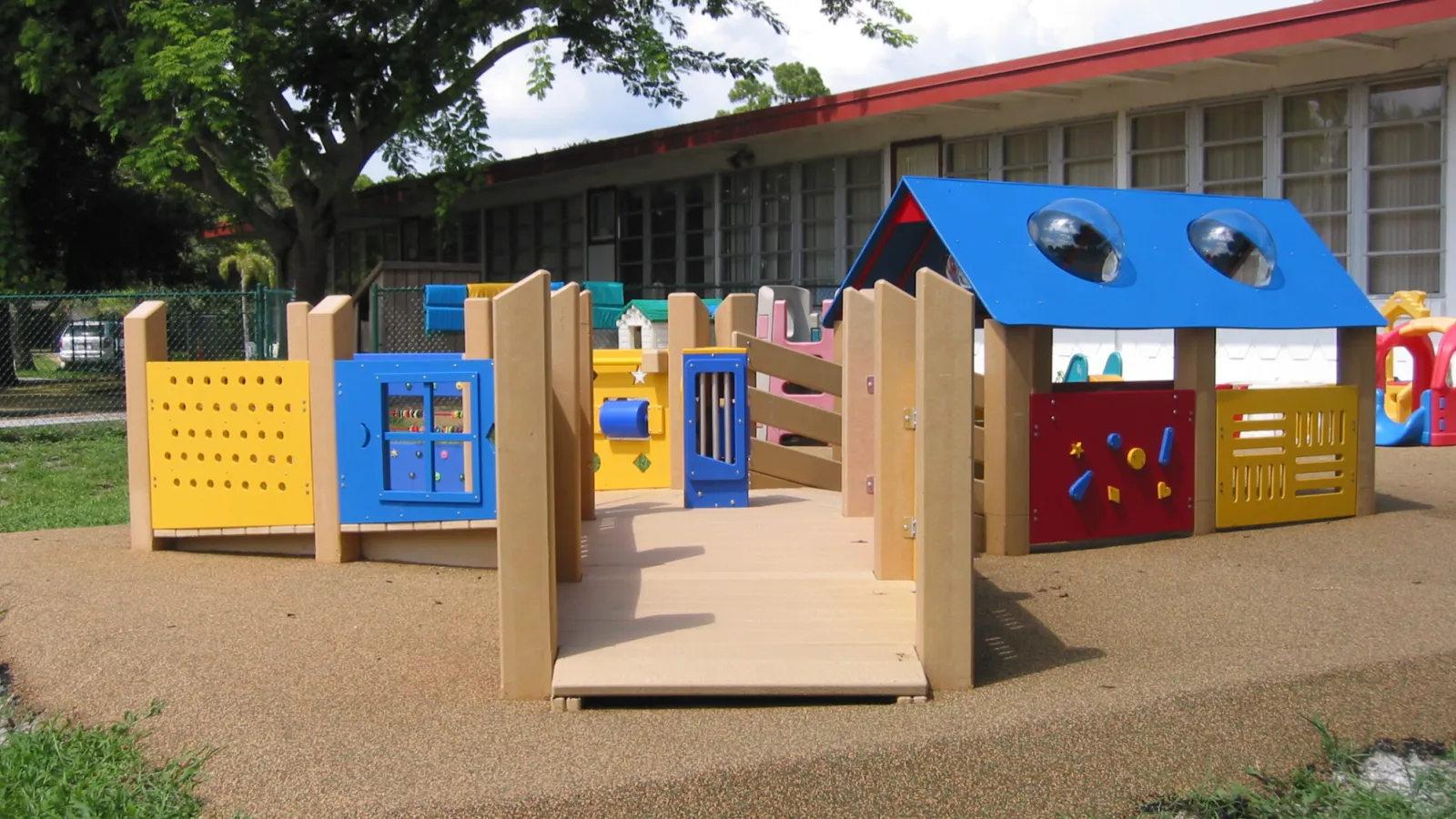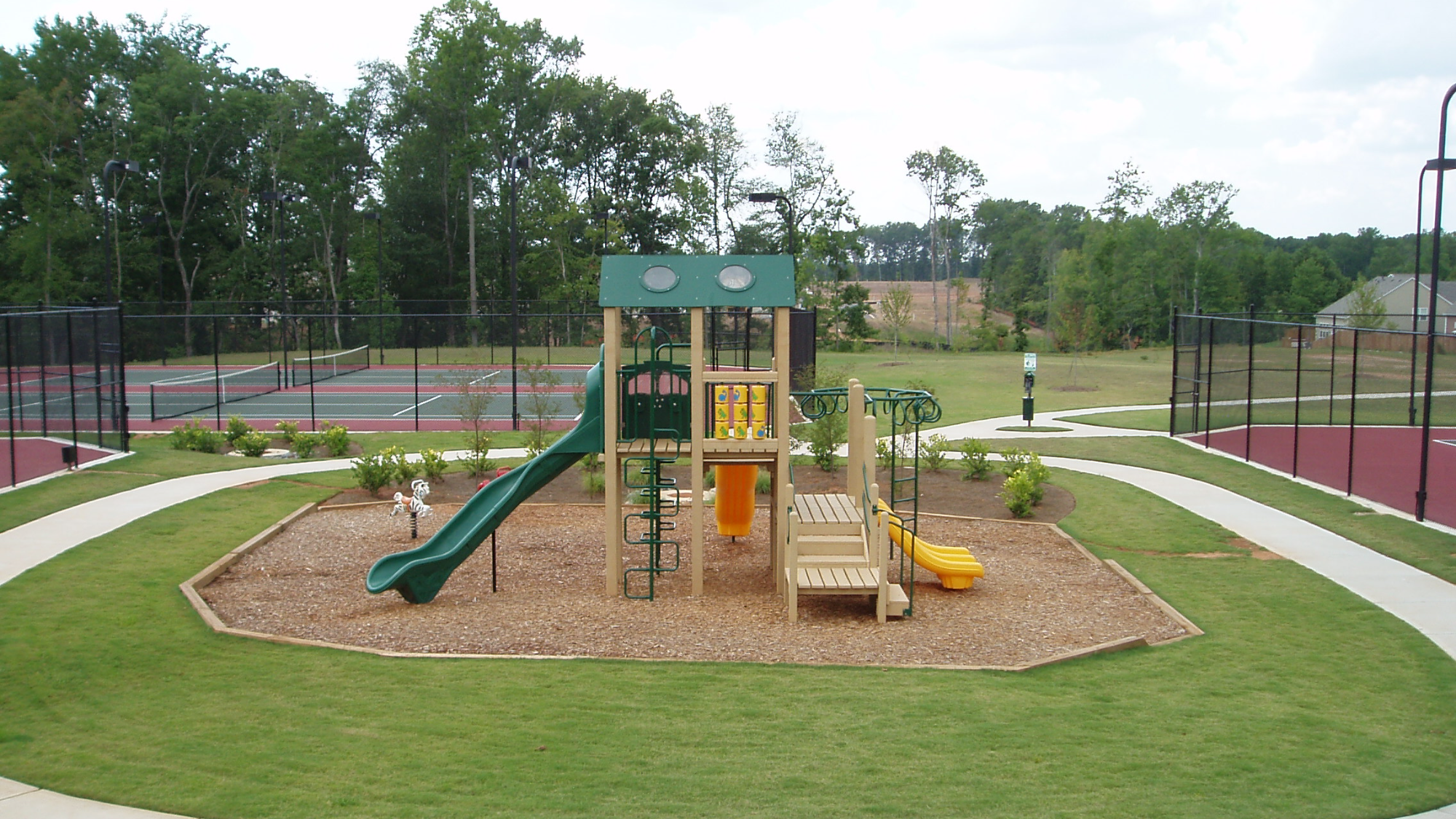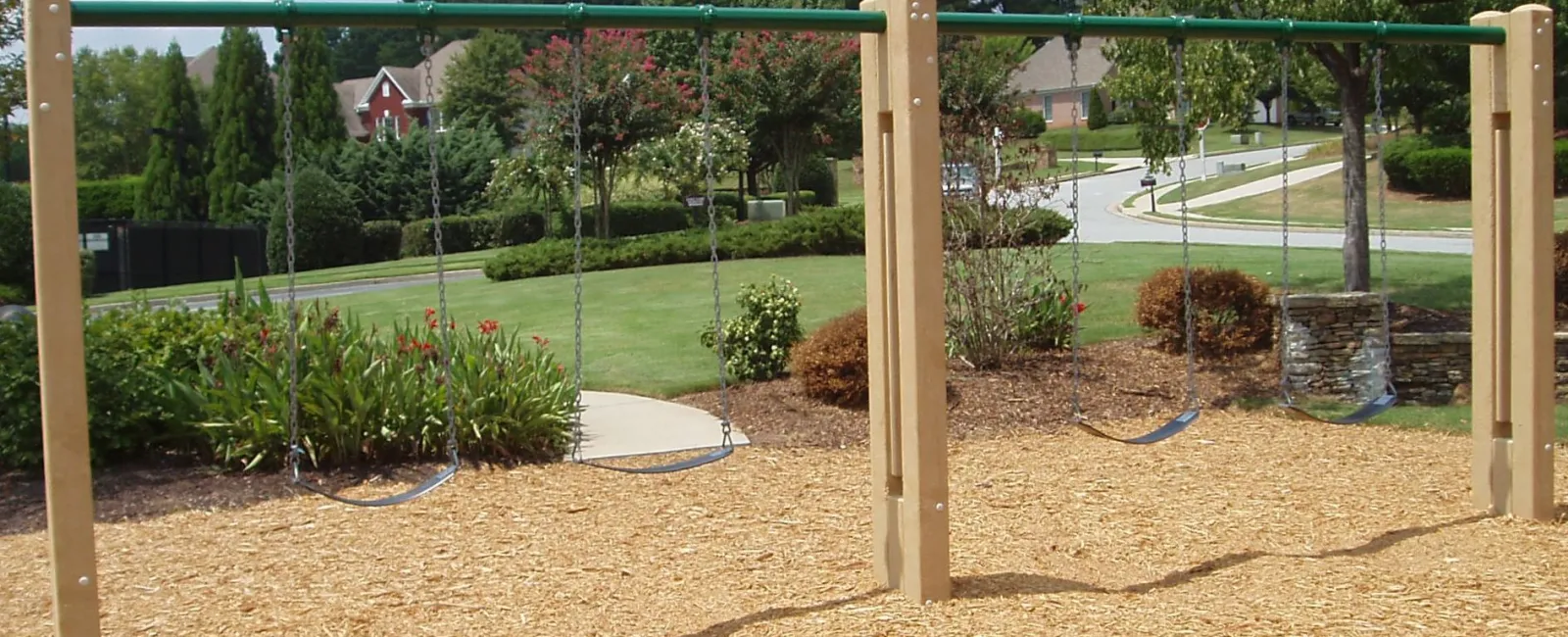Inclusive playgrounds invite all children within your community to play and socialize in a safe environment. While ADA standards require most playgrounds to have accessibility elements, a truly inclusive playground incorporates a variety of different elements for children of all ability levels.
In this post, we discuss what it takes to build an inclusive playground and the benefits of accessibility in play areas. Plus, we take you through a step-by-step walkthrough of how to design, plan, and complete your inclusive playground.
What is an Inclusive Playground?
An inclusive playground is a thoughtfully designed recreational space where children of all abilities can play, explore, and interact together. These playgrounds expand on traditional designs to ensure accessibility for everyone, including those with physical, sensory, and cognitive disabilities.
Key features of inclusive playgrounds include:
Wide, smooth pathways for wheelchair access
Ramps for accessing ground-level and elevated play elements
Transfer platforms for easy navigation
Sensory-rich elements such as textured panels or playground instruments.
Additionally, inclusive playgrounds often incorporate a variety of play equipment that can be used in multiple ways, allowing children to choose activities that suit their abilities and interests.

Swings with secure seats, slides with transfer platforms, and ground-level play components are common elements. Sensory play areas that feature tactile surfaces, sound-making devices, and visual stimuli provide enriching experiences for children with sensory processing differences. These playgrounds also emphasize social interaction by creating spaces where children can play cooperatively. A thoughtful layout and design provide caregivers with the visibility needed to supervise while still providing children with a degree of independence while playing.
The Benefits of Inclusive Playgrounds
Inclusive playgrounds offer a myriad of benefits beyond physical activity.
When designed optimally, an inclusive playground can foster positive social, emotional, and cognitive development in children of all abilities. Here's an overview of the benefits of inclusive playgrounds:
Social Inclusion & Acceptance: An inclusive playground promotes empathy and understanding by enabling children to interact with peers who have different abilities. Through shared play experiences, children learn to appreciate diversity and develop empathy, leading to more inclusive attitudes in their future interactions.
Social Skill Development: Inclusive playgrounds facilitate the development of social skills such as communication, cooperation, and teamwork. By engaging in collaborative play activities, children learn to negotiate, share, and take turns, essential skills for building meaningful relationships and navigating social situations.
Cognitive Development Support: Inclusive playgrounds support cognitive development through sensory-rich experiences that stimulate curiosity, creativity, and problem-solving skills. Elements such as instruments, interactive panels, and imaginative play structures encourage exploration and discovery, ultimately supporting cognitive growth in children of all abilities.
Physical Ability: Inclusive playgrounds promote physical fitness and motor skill development by providing a variety of play equipment and activities that cater to diverse abilities and interests. Children can engage in activities that challenge their balance, coordination, strength, and endurance, promoting overall physical health and well-being.
Increased Self-Esteem: A child's sense of self-esteem and confidence can develop positively with access to an inclusive playground. Accessible play equipment and inclusive design features enable children with disabilities to participate fully in play activities, boosting their sense of competence and belonging.
Community Building: Inclusive playgrounds benefit the broader community by promoting inclusivity, accessibility, and diversity. These playgrounds not only help children learn empathy for their peers but also give parents and caregivers the chance to connect with each other and build a community of support.
4 Key Steps to Designing an Inclusive Playground
When you're ready to start your inclusive playground project, there are several key steps to follow:
Step 1: Choosing Inclusive Playground Equipment
Before you can build your inclusive playground, you must first select the play equipment.
Inclusive playgrounds should include:
Playground Ramps: Playground ramps are essential components not only for building inclusive playgrounds but also for meeting ADA compliance requirements. Ramps provide accessible pathways for children with mobility impairments to access play equipment. These ramps must meet specific requirements outlined in the ADA guidelines, ensuring that children using mobility aids such as wheelchairs, walkers, or crutches can navigate the playground independently. Ramps may feature handrails for added support and safety, and they often connect various play areas and structures, ensuring seamless accessibility throughout the playground.
Sensory Playground Equipment: Sensory playground equipment engages children's senses, primarily touch, sight, and sound. These elements stimulate sensory exploration and provide opportunities for sensory integration, which is beneficial for children with sensory processing differences. Sensory playground equipment may include tactile panels, textured surfaces, interactive light displays, and musical instruments, creating a diverse multi-sensory environment.
Sensory Swings: Sensory swings offer therapeutic benefits for children with sensory processing disorders, autism spectrum disorders, or other developmental disabilities. These swings provide vestibular and proprioceptive input, promoting balance, coordination, and bodily awareness. Sensory swings come in various designs, including platform swings, hammock swings, and cocoon swings, each offering unique sensory experiences. Some sensory swings feature adjustable seating to accommodate children with different body sizes and sensory preferences.
Wheelchair-Accessible Playground Equipment: Wheelchair-accessible playground equipment accommodates children who use wheelchairs or other mobility devices. This equipment can include ramps, transfer platforms, wheelchair swings, and play structures with open decks or lowered sections that allow children to transfer from their wheelchairs onto the equipment safely. Wheelchair-accessible playground equipment may also feature interactive panels and inclusive activities to ensure that all children can participate fully during playtime.
Adaptive Playground Equipment: Adaptive playground equipment is customizable and adjustable to meet the unique needs of children with disabilities. This equipment may include adjustable swings with harnesses or supportive seating, adaptive seats for slides and merry-go-rounds, and sensory panels with adjustable height and angle settings. Adaptive playground equipment allows parents, caregivers, and therapists to modify the equipment to suit each child's abilities and provide optimal support during play. Additionally, adaptive equipment can accommodate children with visual impairments, hearing impairments, or other specific needs, ensuring inclusivity for all children regardless of ability.
Step 2: Checking Your Compliance with the ADA
The Americans with Disabilities Act (ADA) sets legal guidelines that prohibit discrimination against people with disabilities. In 2010, the ADA published its Standards for Accessible Design, which sets clear parameters for accessibility in the design of public facilities.
Per the official ADA Standards:
"Each facility or part of a facility constructed by, on behalf of, or for the use of a public entity shall be designed and constructed in such manner that the facility or part of the facility is readily accessible to and usable by individuals with disabilities."
When applied to playgrounds and outdoor play areas, the ADA Standards for Accessible Design requires new playground constructions to:
Build accessible pathways from the playground to the associated building or parking lot
Build accessible pathways on the playground to ground-level equipment
Build accessible ramps for children with disabilities to access elevated play equipment
Build a minimum number of accessible play components based on the total number of elevated play components (see table below)
(Image source: https://www.ada.gov/law-and-regs/design-standards/2010-stds/)
Step 3: Applying for Grants for Inclusive Playgrounds
Applying for grants to fund inclusive playgrounds can help you build a more engaging playground. However, this requires careful planning, research, and a strategic approach to grant applications.
Here's a step-by-step guide on how to navigate the grant application process effectively:
Research Grant Opportunities: Start by identifying local and regional grant opportunities that support the development of inclusive playgrounds. This can include government grants, foundation grants, corporate sponsorships, and community-based funding sources. Look for grants specifically targeted towards accessibility, inclusive recreation, or child development.
Review Eligibility Criteria: Once you've identified potential grants, carefully review the eligibility criteria, guidelines, and application requirements for each grant opportunity. Make sure your project aligns with the grant's objectives and that you meet the eligibility criteria.
Develop a Comprehensive Plan: Create a detailed plan outlining your inclusive playground project, including the scope, budget, and timeline. Clearly articulate how the playground will benefit children of all abilities and enhance community accessibility and inclusivity.
Gather Necessary Documentation: Collect all the necessary documentation required for the grant application, including organizational information, project budget, design plans, letters of support, and any additional supporting materials.
Demonstrate Community Support: Provide evidence of community support for your project, including letters of support from local organizations, testimonials from community members, and endorsements from key stakeholders.
Write a Compelling Grant Proposal: Craft a compelling grant proposal that clearly articulates the need for an inclusive playground, the goals and objectives of the project, and the anticipated impact on the community. Highlight the innovative features of your playground design, the inclusive amenities, and the benefits for children with disabilities.
Submit Your Grant Application: Follow the application instructions carefully and submit your grant proposal by the specified deadline. Double-check that all required documents are included and that the application is complete. After submitting your grant application, follow up with the grant provider as needed to inquire about the status of your application or to provide any additional information requested. Maintain open communication throughout the review process.
Celebrate Success or Seek Feedback: If your grant application is successful, celebrate your achievement and begin the process of implementing your inclusive playground project. If your application is not successful, seek feedback from the grant provider to understand areas for improvement and consider revising your proposal for future opportunities.
Step 4: Choosing a Playground Manufacturer for Your Inclusive Playground
When selecting a playground manufacturer for an inclusive playground project, several factors should be considered to ensure the successful implementation of the project:
Experience: Prioritize manufacturers with a proven track record of designing and constructing inclusive playgrounds. Look for companies with experience in accessibility standards, inclusive design principles, and a portfolio of successful inclusive playground projects.
Safety: Consider the manufacturer's commitment to safety and quality standards. Choose manufacturers that adhere to industry regulations and ADA design standards for playground equipment safety, durability, and accessibility.
Customization: Assess the manufacturer's capacity to customize playground equipment to meet the specific needs of your inclusive playground project. Look for manufacturers that offer inclusive play elements, including ramps, sensory features, and wheelchair-accessible structures.
Pricing: Always consider factors such as your budget and timeline when selecting a playground manufacturer. Choose a manufacturer that can provide competitive pricing, timely delivery, and ongoing support throughout the planning, design, and installation phases of the project.
As you research different manufacturers, prioritize those that value collaboration and are willing to work closely with you to bring your vision for an inclusive playground to life.

Final Thoughts: Choose EcoPlay for Your Inclusive Play Equipment Needs
At EcoPlay, we design our play equipment to be highly accessible and eco-friendly.
For inclusive playground equipment, EcoPlay offers a wide array of inclusive activities and equipment. Additionally, EcoPlay has a broad selection of ramps, slides, swings, interactive panels, and group activities to accommodate needs of all kinds.
Contact EcoPlay today to start your inclusive playground consultation.
